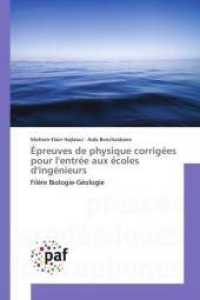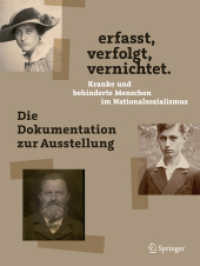- ホーム
- > 洋書
- > 英文書
- > Science / Mathematics
Full Description
In the four years since the 1978 Symposium on the Application of Short-Term Bioassays in the Fractionation and Analysis of Complex Environmental Mixtures the use of short-term bioassays to evaluate potential health hazards of complex environmental mixtures has substantially increased. Increased research activity has been particularly noticeable in mobile source emissions, where initial observations on the mutagenic activity of diesel particulate extracts reported at the 1978 symposium stimulated the development of major research programs in government and industry. In the absence of appropriate reference materials, the U.S. Environmental Protection Agency initiated comparative genotoxicity studies to determine the relative mutagenic and carcinogenic activity and, ultimately, the potential human health risk due to exposure to various complex emission products. Among the materials investigated were those of known health risk, such as coke oven and roofing tar emissions and cigarette smoke condensates, and those of unknown hazard, such as exhaust from diesel-and gasoline-powered vehicles. Studies on diesel emission products proved useful in short term bioassay development, as the diesel exhaust extracts were genetically active with low cellular toxicity and could be obtained in relatively large quantities. Availability of such samples aided chemical characterization, and it was eventually determined that the nitro-polynuclear aromatic hydrocarbons were among the mutagenic components of diesel exhaust particulate.
Contents
Session 1: Collection And Preparation of Environmental Samples for Bioassays.- Some Aspects of Mutagenicity Testing of the Particulate Phase and the Gas Phase of Diluted and Undiluted Automobile Exhaust*.- Source Assessment Sampling System (SASS) Versus Dilution Tunnel Sampling*.- Preparation of Hazardous and Complex Samples for Ecological Testing*.- Sample Collection and Preparation Methods Affecting Mutagenicity and Cytotoxicity of Coal Fly Ash*.- The Use of Short-Term Bioassays to Monitor the Environmental Impact of Land Treatment of Hazardous Wastes*.- Mutagenicity Testing of Complex Mixtures Derived from Human Body Fluids*.- Evaluation by the Tradescantia Micronucleus test of the Mutagenicity of Internal Combustion Engine Exhaust Fumes from Diesel and Diesel-Soybean Oil Mixed Fuels+.- Session 2: Application of Bioassays to the Characterization of Hazardous Components.- Microbial Assays in Research and in the Characterization of Complex Mixtures*.- Fractionation of an Oil Shale Retort Process Water: Isolation of Photoactive Genotoxic Components*.- The Integration of Bioassay and Physiochemical Information for Complex Mixtures*.- Session 3: Development of Short-Term Bioassays: Mutagenicity and Cytotoxicity.- Isolation of Mutagens from Drinking Water: Something Old, Something New*.- Mutagenicity Testing of Complex Environmental Mixtures with Chinese Hamster Ovary Cells*.- Bioassays of Oil Shale Process Waters in Paramecium and Salmonella*.- A Search for the Identity of Genotoxic Agents in the Ambient Air Using the Tradescantia Bioassay*.- Relationship(s) Between Mutation and Cytotoxicity Induced InVitro*.- The Mouse Oocyte Toxicity Assay*.- Application of Bovine Macrophage Bioassays in the Analysis of Toxic Agents in Complex Environmental Mixtures*.- Determination ofDirect-Acting Mutagens and Clastogens in Oil Shale Retort Process Water*.- Unscheduled DNA Synthesis in Hamster Tracheal Epithelium Exposed InVitro to Chemical Carcinogens and Environmental Pollutants+.- InVitro Mutagenicity Testing of Ohio Coal-Derived Materials+.- Presence of Various Types of Mutagenic Impurities in Carbon Black Detected by the Salmonella Assay+.- Session 4: Development of Short-Term Bioassays: Carcinogenicity.- Criterion Development for the Application of BALB/c-3T3 Cells to Routine Testing for Chemical Carcinogenic Potential*.- A Quantitative, Clonal Assay for Carcinogen-Induced Alterations of Respiratory Epithelial Cells in Culture*.- Recent Experience with the Strain A Mouse Pulmonary Tumor Bioassay Model*.- Integrated Chemical and Biological Analysis of Asphalt and Pitch Fumes*.- Mouse Skin Carcinogenesis: Application to the Analysis of Complex Mixtures*.- Session 5: Development of Short-Term Bioassays: Teratology.- Frog Embryo Teratogenesis Assay: Xenoplus (FETAX) -- A Short-Term Assay Applicable to Complex Environmental Mixtures*.- Human Serum Teratogenicity Studies Using In Vitro Cultures of Rat Embryos*.- A Teratology Test System which Utilizes Postnatal Growth and Visibility in the Mouse*.- Session 6: Integrated Assessment.- Mutagenicity of Pulp and Paper Mill Effluent: A Comprehensive Study of Complex Mixtures*.- Evaluation in Man and Animals of Tests for the Detection of Population Exposures to Genotoxic Chemicals*.- Biological Activity of Air Particulate Extracts (APE) in Short-Term Tests*.- On the Use of Relative Toxicity for Risk Estimation*.- Passive Smoking and Urban Air Pollution: Salmonella/Microsome Mutagenicity Assay of Simultaneously Collected Indoor and Outdoor Particulate Matter*.- Environmental Aromatic Nitro Compounds and Their Bacterial Detoxification*.- Application of Mutagenicity Tests for Detection and Source Assessment of Genotoxic Agents in the Rubber Work Atmosphere*.- Mutagens in Airborne Particulate Pollutants and Nitro Derivatives Produced by Exposure of Aromatic Compounds to Gaseous Pollutants*.- *Invited paper.








